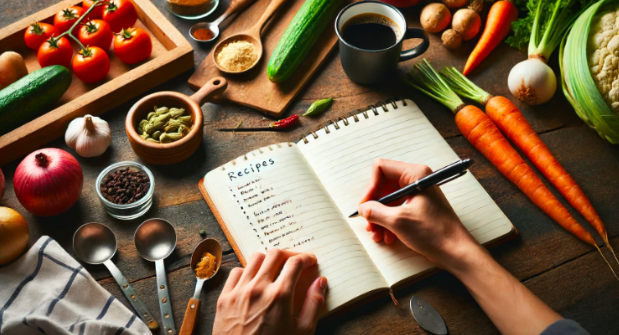
So, you’re ready to write a cookbook, but where do you start? Recipe development for aspiring authors is more than just jotting down a list of ingredients and instructions—it’s the heart and soul of your cookbook. Imagine guiding someone through a culinary journey, where each recipe not only tastes incredible but is also easy to follow. This means mastering the balance between creativity and precision, ensuring that your recipes are reliable and resonate with a diverse audience.
Think of your cookbook as more than just a collection of dishes—it’s a potential kitchen staple, something that home cooks will turn to time and again. To make that happen, you need to focus on creating and refining recipes that are crystal clear and foolproof. Precision is key; your readers should feel confident that they can replicate your culinary creations with consistent, delicious results.
In this article, we’ll walk you through the entire process of recipe development, offering tips and insights to help you craft a cookbook that won’t just sit on a shelf but will become a cherished companion in kitchens everywhere.
The Basics of Recipe Development For Aspiring Cookbook Writers
Developing recipes is the process of creating, testing, and refining recipes to ensure they are both delicious and reliable. This involves more than just combining ingredients; it requires an understanding of how flavors interact, how different cooking techniques affect the outcome, and how to make recipes accessible to a wide audience. The significance of recipe development lies in its ability to transform an idea into a replicable and enjoyable culinary experience. For aspiring cookbook writers, mastering recipe development is crucial as it forms the foundation of their work and directly impacts the success of their cookbook.
Your Publishing Journey Awaits – Start NowRole in the Culinary World
In the culinary world, recipe development is a cornerstone of innovation and tradition. Chefs, food writers, and home cooks rely on well-developed recipes to explore new flavors, preserve cultural heritage, and share their culinary passions. Recipes serve as a bridge between the creator and the audience, conveying not just instructions but also a story, a history, and a sensory experience. Successful recipe development can elevate a dish from a mere meal to an unforgettable experience, making it an essential skill for anyone looking to make a mark in the food industry.
Key Elements of a Good Recipe
The foundation of any good recipe starts with high-quality ingredients and precise measurements. Accurate measurements ensure consistency, allowing readers to replicate the dish exactly as intended. Ingredients should be listed in the order they are used and specified clearly, including details such as size, weight, or type (e.g., “1 cup finely chopped onions” vs. “1 cup onions”). This level of detail helps prevent confusion and ensures that the final dish meets the creator’s vision.
Instructions and Techniques
Clear, step-by-step instructions are essential for guiding the cook through the recipe. Each step should be concise yet detailed enough to eliminate ambiguity. Including specific techniques, such as “sauté until golden brown” or “fold in the whipped cream gently,” helps the cook understand not just what to do, but how to do it. Visual cues and approximate times can further aid in achieving the desired result.
Importance of Clarity and Precision
Clarity and precision are paramount in recipe writing. Ambiguous instructions or vague ingredient lists can lead to frustration and failure. A well-written recipe anticipates potential questions and provides answers, ensuring that even novice cooks can follow along successfully. This attention to detail builds trust with the audience, encouraging them to return to the cookbook for future meals.
Food Safety and Allergies
Food safety is a critical aspect of recipe development. Including proper cooking temperatures, storage guidelines, and handling instructions helps prevent foodborne illnesses. For instance, specifying “cook the chicken to an internal temperature of 165°F” or “store leftovers in an airtight container in the refrigerator for up to three days” provides essential safety information. Incorporating these details demonstrates a commitment to the well-being of the audience.
Addressing Food Allergies and Sensitivities
With the increasing prevalence of food allergies and food sensitivities, it is important for recipes to be inclusive and considerate of these needs. Offering substitutions for common allergens, such as nuts, dairy, and gluten, can make recipes accessible to a broader audience. Additionally, clearly labeling potential allergens and cross-contamination risks helps protect those with severe allergies. By addressing these concerns, cookbook writers can ensure their recipes are safe and enjoyable for everyone.
This comprehensive approach to recipe development not only enhances the quality of the cookbook but also builds a loyal and appreciative readership.
The Cookbook Writing Process
The first step in planning your cookbook is to identify your niche and target audience. Consider what sets your culinary perspective apart and who would be most interested in your recipes. Are you focusing on vegan cuisine, quick and easy weeknight dinners, or perhaps regional specialties? Understanding your niche helps you tailor your content and marketing strategy. Similarly, knowing your audience – whether they are busy professionals, beginner cooks, or gourmet enthusiasts – will influence the tone, complexity, and style of your recipes.
Creating a Book Idea and Outline
Once you have identified your niche and audience, the next step is to develop a compelling book idea and outline. Start by brainstorming themes and concepts that align with your niche. Your book should have a clear and unique selling proposition that differentiates it from existing cookbooks. After settling on a concept, create a detailed outline. This outline should include the main sections of your book, such as appetizers, main courses, and desserts, or thematic sections like “Weeknight Dinners” and “Holiday Feasts.” An organized outline serves as a roadmap, guiding your writing and ensuring a cohesive structure.
Research and Inspiration
Finding recipe ideas is an ongoing process that involves creativity and curiosity. Inspiration can come from various sources, such as seasonal ingredients, family traditions, travel, and even social media. Keep a notebook or digital document to jot down ideas as they come to you. Experimenting in the kitchen and adapting existing recipes to fit your style can also lead to unique creations. Food science plays a crucial role in this experimentation, allowing you to alter the texture, taste, and shape of foods to create innovative dishes.
Studying Other Cookbooks and Culinary Trends
Research is vital in creating a cookbook that stands out. Study other cookbooks in your niche to understand what works and what doesn’t. Analyze their structure, writing style, and recipe presentation. Additionally, keep an eye on current culinary trends by reading food blogs, attending culinary events, and following influential chefs and food writers. Understanding what is popular and why it resonates with people can help you craft recipes that appeal to contemporary tastes while maintaining your unique voice.
Testing and Perfecting Recipes
Recipe testing is a crucial step to ensure your recipes are reliable and delicious. Each recipe should be tested multiple times, ideally by different people, to account for varying skill levels and kitchen equipment. This process helps identify any ambiguities in the instructions and ensures the final dish meets your expectations. Accurate and thoroughly tested recipes build trust with your readers, encouraging them to try more dishes from your cookbook.
Gathering Feedback and Making Adjustments
Feedback from testers is invaluable in perfecting your recipes. Encourage honest opinions and be open to constructive criticism. Testers can provide insights into the clarity of instructions, ingredient availability, and overall taste. Use this feedback to refine your recipes, make adjustments to improve flavor, simplify steps, or clarify instructions. This iterative process of testing and refining helps ensure that your cookbook offers high-quality, reliable recipes that readers will enjoy and trust.
Planning, researching, and perfecting your cookbook not only enhances its quality but also prepares you for the journey of publishing a successful and beloved culinary resource.
Writing Recipes
Writing clear and concise recipes is an art that requires attention to detail and empathy for the reader. Here are some essential tips:
- Use Simple Language: Avoid jargon and complex terms. Use straightforward language that can be understood by cooks of all skill levels.
- Be Specific: Provide precise measurements and detailed descriptions. Instead of “add salt,” specify “add 1 teaspoon of salt.”
- Organize Logically: List ingredients in the order they are used and structure instructions sequentially. This helps readers follow along without getting lost.
- Include Visual Cues: Mention visual signs that indicate progress, such as “sauté until golden brown” or “whisk until smooth and creamy.”
- Break Down Steps: Divide complex tasks into smaller, manageable steps. This prevents readers from feeling overwhelmed.
- Test Your Instructions: Ensure clarity by having someone else follow your recipe. Their feedback can highlight any confusing parts.
Common Mistakes to Avoid
Avoiding common pitfalls can enhance the clarity and usability of your recipes:
1. Vagueness: Phrases like “a pinch of salt” or “cook until done” are too vague. Provide specific measurements and times.
2. Assumptions: Don’t assume readers have advanced cooking knowledge. Explain techniques clearly and avoid ambiguous terms.
3. Skipping Steps: Ensure no steps are omitted, even those that seem obvious. Consistency is key to reliability.
4. Overcomplicating: Keep instructions simple. Overly complex sentences and instructions can confuse and discourage readers.
Enhancing Recipes with Food Styling
The visual appeal of your recipes can significantly impact a reader’s desire to try them. Well-styled food photos make your dishes look enticing and convey professionalism and care.
Basic Food Styling Techniques
1. Use Fresh Ingredients: Fresh, vibrant ingredients photograph better and make the dish look more appetizing.
2. Play with Colors and Textures: Contrast colors and textures to make the dish visually interesting. Garnish with fresh herbs, citrus slices, or a drizzle of sauce.
3. Keep It Natural: Avoid over-styling. Natural, slightly imperfect looks often appear more authentic and appealing.
4. Consider the Background: Use simple, clean backgrounds that complement but don’t overpower the dish. Neutral tones work well.
5. Lighting is Key: Natural light is best. Shoot near a window and use reflectors to minimize shadows and highlight the food’s texture.
The Complete Recipe Writing Guide
1. Title and Description: Start with a catchy title and a brief description that entices readers and gives an overview of the dish.
2. Ingredient List: List all ingredients in the order they are used. Include precise measurements and specify any unusual items or substitutions.
3. Preparation Instructions: Break down the recipe into clear, concise steps. Number each step and use short sentences for clarity.
4. Cooking Times and Temperatures: Specify exact cooking times, temperatures, and any required equipment (e.g., “bake at 350°F for 20 minutes”).
5. Visual and Sensory Cues: Include cues that indicate doneness or the desired state of the dish, such as “until golden brown” or “until the sauce thickens.”
Ensuring Completeness and Accuracy
Your Publishing Journey Awaits – Start NowTo ensure your recipes are complete and accurate:
1. Double-check Measurements: Verify that all measurements are correct and consistent.
2. Consistency in Terms: Use consistent terminology throughout the recipe to avoid confusion.
3. Test Multiple Times: Test your recipe several times, ideally in different kitchens and by different cooks, to ensure it works under various conditions.
4. Gather Feedback: Solicit feedback from testers and be open to making adjustments based on their experiences.
5. Proofread Carefully: Check for any typos, missing steps, or unclear instructions before finalizing the recipe.
Crafting clear, concise recipes with appealing visuals and ensuring thoroughness and accuracy will not only enhance the usability of your cookbook but also build trust and loyalty with your readers.
Getting Published
When it comes to publishing your cookbook, you have two main options: traditional publishing and self-publishing. Each has its own set of advantages and challenges.
Traditional Publishing: This route involves submitting your manuscript to a publishing house, which, if accepted, will handle the production, distribution, and marketing of your book. The advantages include access to professional editing, design, and marketing teams, as well as the prestige of being published by a recognized name. However, it can be a lengthy and competitive process, often requiring a literary agent, and the author typically receives a smaller percentage of the profits.
Self-Publishing: Self-publishing gives you full control over the entire process, from writing and editing to design and marketing. This option allows for a higher profit margin and a quicker publication timeline. However, it also means that you are responsible for all aspects of the book’s production and promotion, which can be time-consuming and require a significant investment.
How to Get a Book Deal
To secure a book deal with a traditional publisher, follow these steps:
1. Develop a Strong Proposal: Your book proposal should include a compelling overview of your book, a detailed outline, sample recipes, and a market analysis. Highlight what makes your cookbook unique and why it will appeal to readers.
2. Find a Literary Agent: Many publishers only accept submissions through agents. Research agents who specialize in cookbooks and submit your proposal to them.
3. Submit to Publishers: If you have an agent, they will handle this process. If not, look for publishers that accept direct submissions. Be prepared for rejections and keep refining your proposal.
Working with Publishers and Editors
Building a positive relationship with your publisher is crucial for the success of your cookbook. Communication is key; be clear about your vision for the book but also be open to their expertise. Publishers have a wealth of experience in the market and can provide valuable insights into what works.
Editors play a vital role in shaping your manuscript into a polished and professional product. They will help refine your writing, improve clarity, and ensure consistency throughout the book. Embrace their feedback and collaborate closely with them to enhance the quality of your cookbook. Remember, their goal is to make your book as successful as possible.
Marketing and Promoting Your Cookbook
Effective marketing is essential to the success of your cookbook. Consider these strategies:
1. Book Launch Events: Host events at local bookstores, cooking schools, or online to create buzz and engage with your audience.
2. Media Appearances: Reach out to food bloggers, local newspapers, magazines, and TV shows to feature your book.
3. Collaborations: Partner with food influencers, chefs, and other cookbook authors to broaden your reach.
Social Media and Blogs
Social media and blogs are powerful tools for promoting your cookbook:
1. Social Media: Use platforms like Instagram, Facebook, and Twitter to share recipes, and behind-the-scenes content, and engage with your audience. Regularly update your followers with news about your book and upcoming events.
2. Blogging: Start a blog or contribute guest posts to established food blogs. Share stories and recipes from your cookbook to entice readers to buy the full book.
3. Email Newsletters: Build an email list and send out regular newsletters with exclusive content, recipe previews, and promotional offers.
By understanding the publishing industry, effectively working with publishers and editors, and implementing strategic marketing efforts, you can successfully navigate the path to getting your cookbook published and reaching a wide audience.
Additional Tips and Resources
For aspiring cookbook writers, continuous learning is essential. Consider enrolling in courses at reputable culinary institutes such as the Culinary Institute of America (CIA) or Le Cordon Bleu. Online platforms like Coursera, Udemy, and MasterClass offer specialized courses in recipe development, food writing, and culinary arts. These programs can enhance your skills, keep you updated on the latest trends, and provide valuable credentials.
Importance of Ongoing Learning
The culinary world is constantly evolving, with new techniques, ingredients, and dietary trends emerging regularly. Staying informed and continually refining your skills ensures that your recipes remain relevant and innovative. Ongoing education helps you maintain a competitive edge and inspires creativity in your recipe development.
Networking in the Culinary World
Networking is crucial for professional growth and opportunities in the culinary field. Attend culinary events, food festivals, and industry conferences to meet other cooks, chefs, and food writers. Engage with your peers, share experiences, and learn from each other. Building these connections can lead to collaborations, mentorships, and new opportunities.
Joining Culinary and Writing Communities
Becoming a member of culinary and writing communities can provide support and resources. Organizations such as the International Association of Culinary Professionals (IACP) and local writers’ guilds offer networking opportunities, workshops, and industry insights. Online communities and forums also provide a platform to connect with like-minded individuals and gain valuable feedback on your work.
Comprehensive Resource List
Books, Blogs, and Online Resources
Expand your knowledge and skills with resources such as:
- Books: “The Food Lab” by J. Kenji López-Alt, “Salt, Fat, Acid, Heat” by Samin Nosrat, and “The Flavor Bible” by Karen Page and Andrew Dornenburg.
- Blogs: Smitten Kitchen, Serious Eats, and David Lebovitz’s blog offer inspiration and practical advice.
- Online Resources: Websites like Food52, Epicurious, and Bon Appétit provide a wealth of recipes, tutorials, and industry news.
Tools and Equipment for Recipe Development
Invest in essential kitchen tools and equipment to aid your recipe development process. Quality knives, measuring tools, and cooking appliances are fundamental. Additionally, software tools for recipe management and nutritional analysis can streamline your work and enhance the precision of your recipes.
Your Publishing Journey Awaits – Start NowContinuing education, networking, and utilizing comprehensive resources will support your journey as an aspiring cookbook writer, helping you create high-quality, innovative cookbooks that resonate with readers.
cooking guide you. With dedication and perseverance, you can create a cookbook that inspires and delights readers, leaving a lasting impact in the culinary world.
Embracing Your Cookbook Writing Journey
Writing a cookbook is more than just compiling recipes—it’s an exciting and rewarding adventure that blends creativity, culinary expertise, and dedication. As you embark on this journey, remember that you’re not alone. In this article, we’ve delved into the essential aspects of recipe development, uncovered the complexities of the cookbook writing process, and shared insights from successful authors. We’ve also touched on the importance of crafting clear, concise recipes, enhancing them with food styling, and effectively marketing your cookbook.
For many aspiring cookbook writers, the road ahead might seem overwhelming. But keep in mind that every successful author began with just one recipe and a deep passion for sharing their culinary creations. Embrace the learning process, seek out feedback, and remain persistent. The skills you develop will not only refine your recipes but also boost your confidence as both a writer and a chef.
Your cookbook writing journey will be filled with its share of challenges and triumphs. From the first spark of inspiration to finally holding your completed book, each step is a testament to your hard work and passion for food. Stay true to your unique voice and vision, and let your love for cooking shine through every page.
Have you completed your manuscript and are ready to share it with the world? Spines stands as your gateway to the publishing realm, embodying the future of publishing. Our AI-powered platform is designed to revolutionize your publishing journey, offering a suite of comprehensive services. These include detailed editing and proofreading, captivating cover creation, seamless distribution, and strategic marketing across various channels and platforms. With Spines, your book is not only set to transcend the ordinary but also to make a significant impact in the new era of publishing. Sign up for free to start your self-publishing journey.







